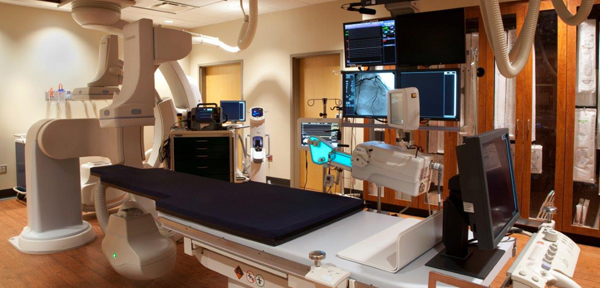
Doctors at St. Charles Parish Hospital are now able to diagnose and treat several heart conditions, and even prevent heart attacks from occurring, thanks to the completion of a $2.4 million cardiac catheterization lab.
Cardiac catheterization is a procedure where a thin, flexible tube called a catheter is put into a blood vessel in a person’s wrist or groin and threaded to the heart.
Through the catheter, doctors can perform diagnostic tests and take an ultrasound to see blockages in the coronary arteries. If blockages are found, stents can be used to open the artery and get blood moving back to the heart, which can prevent heart attacks from occurring in the future.
The first patient treated at the new cath lab was a 59-year-old woman who felt pain in her chest while cleaning her home earlier this month. The woman, who did not wish to be identified, attempted to work through the pain but found it unbearable, so she headed to the St. Charles Parish Hospital’s emergency room.
Medical staff spotted abnormalities in her EKG readings along with a spike in her blood pressure. She was admitted to the hospital and met with Dr. Christopher Paris, an interventional cardiologist with the Cardiovascular Institute of the South.
Paris scheduled a stress test by having the woman walk on a treadmill, but she was unable to finish.
“The treadmill brought on a pain unlike anything I had ever felt. I would put it right up there with child birth,” the woman said.
The pain the woman felt was being caused by a blockage in her artery. Because the cath lab had been completed days before, the patient was scheduled for a procedure that would remove the blockage.
The procedure, which only lasted an hour and a half, drastically improved the woman’s health.
“Normally when I stand up I am short of breath and have pain, but now I feel nothing,” she said.
Ryan Hebert, director of the cath lab, said testimonials like the one above will become commonplace as more lives are improved because of the hospital’s new technology.
“Those patients that are having chest pain on a regular basis, generally there is a cause for that. We are able to diagnose (the cause of the chest pain) with visual pictures and treat it right here with all the latest in state-of-the-art technology,” he said.
Hebert said the cath lab allows doctors to get pictures of the heart and any other blood vessel in the body. Those images help them diagnose patients quickly.
For example, doctors may put a special type of dye in the catheter that will flow through the bloodstream to the heart. The dye can show whether a waxy substance called plaque has built up inside the coronary arteries. Plaque can narrow or block the arteries and restrict blood flow to the heart.
Doctors can also use an ultrasound during cardiac catheterization to see blockages in the coronary arteries. Ultrasound uses sound waves to create detailed pictures of the heart’s blood vessels, which can show any blockages that are present.
“You have normal tubes that provide blood to specific areas of the body. Over time, those tubes can kind of get a kink in them. We basically do what a plumber does – we go in and clean it out while offering reinforcement,” Hebert said.
While plumbers use PVC pipe for reinforcement, doctors use a stent that reinforces the walls of a vessel so that it is able to function normally.
While the procedure seems invasive, Hebert said most patients who have blockages removed can go home the same day.
“We can actually get one of those blood vessels open in less than 15 minutes,” Hebert said.
The speed of the procedure is important in the case of heart attacks. Before the hospital built the cath lab, patients in St. Charles Parish who suffered heart attacks would have to be taken to a hospital in another parish. Now, the hospital has all the tools needed to treat those patients in Luling.
“The longer the heart attack lasts, the less muscle that recovers. You can’t replace muscle. Once it dies, it’s dead,” Hebert said. “While we want to prevent a heart attack by detecting and removing blockages early, if it does happen we have the tools to treat it as quickly as possible and give people a fighting chance to recover from it.”
By quickly inserting a catheter and using it to open an artery, blood can return to the heart and save the muscle.The cath lab can also be used to treat people who have issues with their legs.
“There are individuals who have trouble walking a couple steps without getting cramps in their legs or being in excruciating pain. Those individuals usually have blockages in their legs as well,” Hebert said. “We are able to go in through arteries, look at what’s going on, and if we find significant blockages, we are able to clean those out to where they are able to start walking again.”
Along with the cath lab, St. Charles Parish Hospital is also building a $2.3 million cardiac clinic inside the hospital. Cardiovascular Institute of the South will rent out the space from the hospital and run the clinic, which should be completed by June.
The clinic consists of 16 exam rooms, a nuclear medicine room, a stress treadmill room with two treadmills, two echocardiology rooms, a pacemaker room and a laboratory for blood work.




Be the first to comment